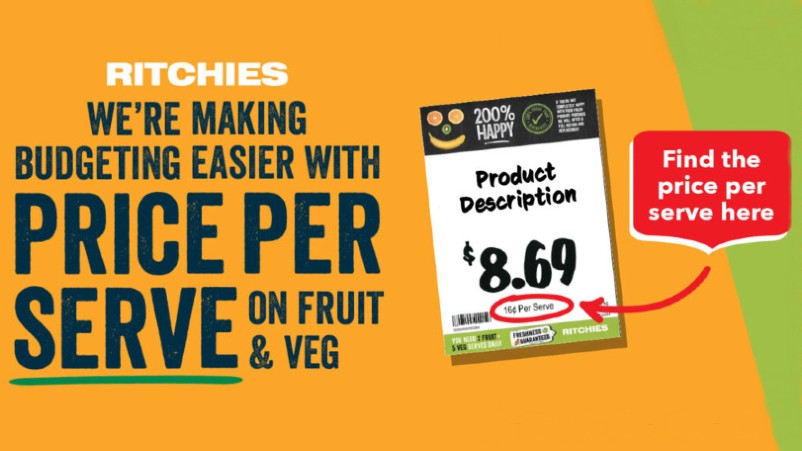Tapping consumer psychology to drive both healthier customers and bottom line: Ritchies per nutritional serve pricing arrives in stores, sees 6% increase in veg sales

Consumers are understandably sceptical about any changes supermarkets make to pricing tickets right now. Yet Ritchies is confident it can back up a 6 per cent uplift in fresh vegetable sales by permanently bringing in what it sees as more useful per nutritional serve pricing to fresh fruit and vegetables aisles. The independent supermarket chain partnered with Monash University on a joint academia-industry program exploring the issue of fruit and vegetable affordability across Australia, plus the dire gap between the ‘two-and-five a day’ recommendations of health experts versus actual amounts consumed by Aussie adults. Pilot results were so encouraging, Ritchies has rolled out per-serve pricing across all 76 stores, directly connecting nutritional serving sizes to sticker prices for the first time. It’s no silver bullet, but a small step towards benefiting consumer health while overcoming price barriers many cash-strapped Aussies are erecting in the face of the cost-of-living crisis, Monash and Ritchies say. It should also help win over consumers increasingly wary of the pricing narrative Australia’s dominant supermarket giants put in front of them.
What you need to know:
- After conducting a successful trial with Monash in one store of pricing displaying fresh fruit and vegetable prices on a pernutritional serve basis, Ritchies Supermarkets has rolled out the novel pricing format to all of its 78 stores.
- The idea first came from Monash Uni researchers, who reached out to independent supermarket chain to trial the impact having perserve pricing based on recommended nutritional serves of fresh fruit and vegetables could have on perceptions of affordability. The pilot delivered a 6% increase in fresh Veg sales.
- Similar online UK trials also showed uplift in spending on fresh fruit and vegetables when serving portions are similarly equated.
- Educating customers is critical to ensuring they understand the relevance of the pricing changes, and Ritchies has created collateral, visuals and FAQs as well as trained all staff to ensure they can explain why the pricing is there and how it benefits customers.
- There’s no silver bullet to getting fruit and veg consumption up, nor tackling food waste, but for Ritchies CEO and Monash Uni researchers, directly connecting perserve recommendations to pricing at the point of sale is an important step towards in achieving both.
- The costof-living crisis has also heightened scrutiny of prices in supermarket aisles, making this an arguably even more important time to be launching such pricing both say – and even in the face of growing consumer mistrust of Australia’s supermarket giants and grocery pricing overall.
Have you ever wondered why retailers and greengrocers stick to per-kilo pricing on fresh fruit and vegetables? It’s a question Ritchie’s Stores CEO, Richard Harrison, has asked himself over his 30+ years working in the supermarket trade. And it’s one that led him to join forces with Monash University academics when they came knocking asking to partner up on a new pricing initiative for fresh fruit and vegetables.
Australian health guidelines recommend each of us consumes two pieces of fruit at 150g, and five serves of vegetables, at 75g, per day. Yet according to Australian Bureau of Statistics data, only 6.5 per cent of Australian adults meet these veg recommendation guidelines, and only 44.1 per cent hit the fruit marker. According to scientific research, affordability of these items is a key barrier to consumption.
The hypothesis Monash Uni had was that an inhibitor is pricing done by weight and by kilo, rather than aligned to the quantity of fruit or veg we should consume.
“If you look at five serves of veg at 75g per serve, that’s 375g. That’s a solid consumption of vegetables. But if you went around and looked at beans at $12.99 per kilo, or other vegetables, it might seem expensive to you,” says Harrison. “When you bring it back to cost per nutritional serve, the consumer relates to that.”
Think about it: Most things in the grocery aisle are marked on a per-item basis – a $1.50 for a can of baked beans or $1.80 for a bottle of soft drink, for instance. The idea behind the per-serve pricing is to highlight that even though fresh green beans might be $12.99 per kilo, that’s only $0.97 per serve.
“That’s been our desire – to make it easier for customers, and to encourage customers to revert to the old two and five serves of fruit and veg each day,” says Harrison.
Trialling per-serve pricing in the supermarket
The initial trial between Monash Uni, Deakin University and Ritchies conducted over several months led to a 6 per cent increase in veg sales, independently verified by Monash. The results are more complex with fruit, says Monash associate professor and research instigator, Fiona Newton – arguably due to the doubling of per-serve sizes compared to vegetables. A subsequent Monash online panel trial covering intent for purchase with 800 consumers in the UK, where recommended vegetable and fruit weights are equal weights (80g), saw a similar uplift across both categories.
It was enough for Ritchies to buy in. As of 13 March, every kilo price listed in Ritchie’s fruit and veg aisles is accompanied by a price per nutritional serve on the ticket. The retailer has kicked off advertising in weekly handles, going to about 600,000 letterboxes per week, plus a raft of PR activities including a spot on TV program, Sunrise.
Ritchies has adopted a tagline and symbol, ‘Ritchies’ 2 + 5 fruit & veg’, displayed on all produce stalls, plus signage showcasing examples of what 75g of certain vegetables looks like, as well as 150g of fruit, against a per-kilo equivalent. For example, 1 medium banana or apple, three florets of broccoli from the stem, and half a carrot again a full kilo of each.
Online, there’s an explainer breaking down a 1kg price into a per-serve for each category, FAQ, as well as link to Monash University’s research. In addition, working with Monash Uni, Ritchies has trained up thousands of staff members to help educate consumers on the Australian-first. This covers why the initiative is important, what is a nutritional serve and what the pricing is all about.
Harrison knows there’s an education process with customers to be undertaken. He sees taking up per-serve pricing as a long-term game for Ritchies, driven both by the health benefit for consumers, while potentially helping the hip pocket.
“It won’t all change today or tomorrow, it’s a marathon for us – it’s about talking to the consumer in a more relevant way,” Harrison says. “We also know now the consumer often over-purchases and a lot gets thrown out. As has been said, the number one customer for produce is the rubbish bin. If we can help customers be a little more responsible with how they purchase produce – if they are feeding a family of four, at least you know if you buy 200-300g of fresh produce items to tick the box of five serves per day.
“I think with the rise of Uber and takeaway food, nutritional serves have been pushed into the background. If we can do a little more to be proactive about getting people to eat two and five, we’re delighted with that. At the same time, one of the benefits will be the price piece.”
Providing customer feedback stays positive, Harrison would like to see this across the full IGA network, of which Ritchie’s is a member of.
“There is no patent on it – Woolies, Coles, every fruit shop in Australia can do this. We’re not precious,” he says. “The anecdotal feedback from customers was encouraging, saying thank you for trying to make this simpler. They’re often trying to do the sums in their heads. No one has criticised us for or suggested this is irrelevant.”
I’ve never met so many people now fixated on price. People would say when I first pitched this, that they wouldn’t see it or notice it. I don’t think you can say that now, There’s a very sizeable market now looking at every cent they spend.
Tapping consumer psychology and getting over supermarket skepticism
Monash’s Newton tells Mi3 the price play is a classic example of employing consumer psychology and insights to solve a “wicked little problem” – in this case, Australia’s inadequate fruit and vegetable uptake. An interesting insight she picked up canvassing shoppers was the discrepancy around price consideration when considering fruit and vegetables versus other snacks.
“We had this insight from one mum who has been buying good, exotic fruits [frozen]. She told me she can justify this as it’s relatively comparable to the price of a candy bar,” Newton says. “And she’s positioned this to her kids as an exotic, special treat. That was the genesis of an idea for our research.
“I went down the supermarket aisles countless times and thought hang on, 1kg hides the fact it’s 13.33 nutritional servings. And 1kg of fruit upfront hides that it’s 6.7 servings of fruit. If you don’t think about it that way, it doesn’t look like value for money. There’s sticker shock.
“Parents are now able to simply compare a price for a nutritional serve versus the thing eaten in one go from the snack aisle. It shows fruit and veg are value for money. Guess what: $4.99 per kg for an apple is only $0.79 per serve.”
Newton was onsite every week during the Ritchies trial, and says some shoppers didn’t know what one nutritional serve was, while others were surprised it’s just 75g of vegetables, and you only need five per day.
“One mum said that’s budget saving – I couldn’t see the value before, now I do,” Newton says.
If we can do a little more to be proactive about getting people to eat two and five, we’re delighted with that. At the same time, one of the benefits will be the price piece.
Overcoming growing mistrusts around supermarkets
As Newton points out, the original trial took place in a very different economic climate and sentiment. Since proving its viability, rate hikes and inflation have triggered a cost-of-living crisis in Australia. What’s more, sentiment as supermarket giants continue chalking up profits as consumers are struggling has plummeted. It’s led to numerous investigations into grocery pricing and potential anti-competitive behaviour, from the Senate Inquiry into Supermarket Pricing going on right now, through to the ACCC’s newly proposed Supermarket Inquiry announced in late January.
“We were worried about launching at the same time as the Supermarket Senate Inquiry. We had many conversations about it. I’ve never met so many people now fixated on price. People would say when I first pitched this, that they wouldn’t see it or notice it. I don’t think you can say that now,” Newton says. “There’s a very sizeable market now looking at every cent they spend.
“Consumer prejudice and people thinking it’s another trick” by the big guys was another real concern for Newton and the team.
“When we explained when you weigh it, that’s the same as what you are paying now, they got it,” she says. “It’s not changing what you pay at the checkout, it’s just making price per serve transparent to you. In doing so, we’re helping you make comparisons and your decision making.”
Secondly, what happens if it’s not exactly 150g cropped up. “You may be a bit under or over but and pay a bit less or more as a result. That’s it. It’s that simple,” Newton says.
“When you are making decisions in the produce aisle, we now have nutritional serve costings and brought that in with price. The value of that is profound – it’s not there just for the sake of it. If you meet these servings, you reduce your risk of some pretty serious medical conditions like diabetes and some forms of cancer.”
Newtown knows a key part of education is consumers understanding how much fruit or veg is in a serve physically. In-store and online, Ritchies has been working to explain what it is, although it can’t do every vegetable, and there’s some reliance on consumers Googling to find out. That doesn’t detract from impact, argues Newton.
Newtown admits to a concern the researchers would be knocked back when they first approached Ritchies wanting to shake up pricing displays.
“Doing something with pricing might be the boring element, but it’s very complex behind the scenes. Ritchies marketing manager worked hard to get all the systems correct, get it fitted in and pricing updated. Now we sit and wait and see what the market does yet,” she says.
“And we are learning as we go. For a small independent supermarket to try this is a big deal. This goes into how it’s priced, the ticketing process – when you think about price and displaying that in fresh produce, you only have limited space on the price ticket. How to convey that in a way that’s transparent and easily translated to different languages is key. A lot of thought has gone into it.”
For Newton, consumers will ultimately make up their own minds as to whether they use it or not.
“They still have per kilo pricing and have that choice,” she says. “In the cost-of-living crisis, measuring and maximising the value of every dollar, then this will help you. You won’t be put off by sticker price, that kilo is 13.3 per serves of veg. We’re making that very clear now – that’s its value.
“It’s a small step to helping all those people not meeting servings of veg and fruit. It’s not a silver bullet – there isn’t one. But it’s a jolly good step in the right direction. And Ritchies has first mover advantage.”
As well as long-term sales impact, the next step for Monash is what happens to fruit and veg when it gets home.
“I come from a psyche background, and being back working within industry, addressing really complex, wicked issues and problems like fruit and vegetable consumption where there are so many drivers and barriers – this brings a smile to our faces,” Newton adds.



